Here is a list of birds with photos that belong to the U.S and some of which frequently visit the backyards of the U.S , these U.S bird characters, colors, and food is also mentioned along with some cool facts about them.
Table of Contents
Comman Birds In United States
1. Bald Eagle (Haliaeetus leucocephalus)

The bald eagle is the U.S. national bird and is found around the region of North America and also in Alaska. Habitat: Their habitatsinclude forested areas, fish processing plants, dumps, dams, tall coniferous, and tall deciduous trees.
Identification: These Bald eagles are identifiedby their characteristics such as white-tail and bald head because the head has white feathers it is called so and the bald eagle’s body mass is about 6 kg with a wingspan of 2.3 m and can live for up to 20 years. The male bald eagles weigh less than the females, which is interesting.
Food: Bald eagles eat a wide variety of foods depending on their habitat, this includes fishes such as salmon, herring, shad, and catfish, birds, reptiles, amphibians, crabs, and rabbits. They are unique, easy, and passive hunters as they are not directly engaged in finding their food in most cases, but they chase the birds with food, mostly fish foods, to force them to drop their food or fish collected in the air by these eagles.
2. Golden Eagle (Aquila chrysaetos)
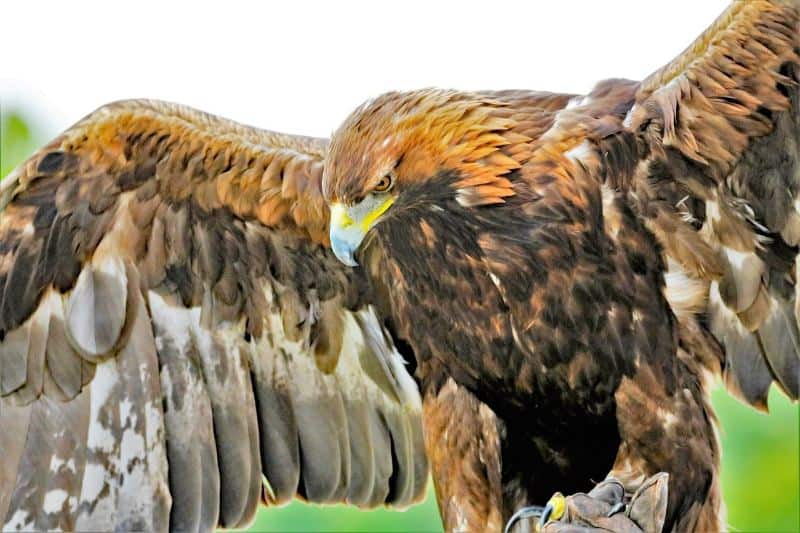
The Golden eagle is foundin North America, that often tends to go during the breeding season to Canada, Alaska, Mexico, and the west side of the United States. Habitat: Its habitatinclude forest, mountains, canyonlands, rimrock terrain, grassland, shrubland, riverside cliffs and bluffs
Identification: These are identified by their body characteristic that is unique since it can achieve a speed of 320 km/h using its relatively longer wingspan of 2.3 m, with a length of up to 100 cm, with a male body weighing approximately 3.6 kg, a female body weighing up to 7 kg, and have dark brown, with lighter golden-brown plumage. The golden eagle is the national bird of Mexico.
Food: For food the Golden eagles are known to kill larger prey birds such as cranes, wild birds, and domestic birds, but most preferably they hunt mammals, rabbits, squirrels, and small puppies.
3. European Starling (Sturnus vulgaris)
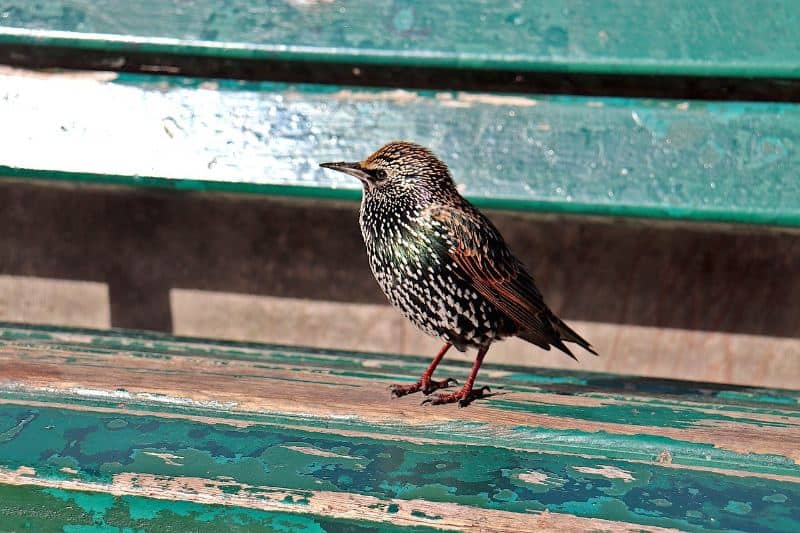
European Starlings are currently found in the United States, Central America, Puerto Rico, Jamaica, and Cuba. Habitat: Whose habitats include mowed lawns, city streets, agricultural fields open and grassy areas. Eugene Schieffelin, who made a good habitat for starlings, introducing them to America.
Identification: The European Starling are identified by their physical feature that includes about 20 cm of length, 100 gm of weight, has glossy plumage, this belongs to the Sturnidae family.
Food: The food of the Starlings are berries, fruits, beetles, grasshoppers, flies, spiders, caterpillars, snails, earthworms, and small invertebrates. The European Starling that is frequently found in urban areas visits bird feeders readily.
4.Mourning Dove

The Mourning Doves are foundin North America. Habitat: Whose habitatsinclude open country, scattered trees, woodland edges, grasslands, agricultural fields, and backyards.
Identification: The Mourning Dove is identified by the incubation period required for the eggs of the Mourning dove is around 14 days and the nestling period is around 12-15 days. The oldest known Mourning Dove was a male, about 30 years old, and these birds mate for life.
Food: They feed on seeds more than insects and are known to eat weed seeds that are beneficial to farmers as they avoid the growth of weeds. The crop milk or pigeon milk is produced in the crop and is rich in protein and fat, that is fed to chicks and are also known to store food in their crops.
These are interesting birds because even though these are being hunted by around 20 million in numbers but their population remains unchanged due to their huge population that is around 350 million. They found to show social display by flying three Mourning Dove together during the breeding season.
5.Black-Capped Chickadee (Poecile atricapillus)

The black-capped chickadee is a North American songbird that is found in forests as a non-migratory bird. It is also found in Maine, Massachusetts, and Canada. Habitat: Its habitatsinclude deciduous forests, mixed forests, open woods, parks, willow thickets, and cottonwood groves.
Identification: These birds are identified by their small wings and a short tail, black bib, white cheeks, back soft gray, and white wingtips. and are about 15 cm long and weigh up to 15 g.
Food: The foods of the black-capped chickadee include seeds, fruit, nuts, insects, invertebrates, and even sometimes the little bits of carrion that make them omnivorous creatures and are known to consume suet and peanut butter. They hide foods in different locations, particularly the seeds, and then return to the same place to eat them, which makes them interesting birds because they remember the various places with different foods.
6.Blue Jay

Blue Jays are found in the eastern United States, eastern United States while in summer they live in southern Canada. The northern Blue Jay has dull plumage and pale blue colors that are found in Canada and the northern U.S. The Coastal Blue Jay has a vivid blue color that is found on the southern coast of the eastern U.S and the Florida blue jay the smallest blue jay. Habitat: Its habitats include all kinds of forests, woodlands, oak trees, forest edges, urban and suburban areas.
Identification: These are identified by their features that includes a length of 12 inch, a weight of 100 g, and a wingspan of 17 inch. The color at the dorsal surface is Blue while the ventral surface is white and white patches in the wing.
Food: As Blue Jay are omnivorous birds their food ranges from plant to animal-derived foods that can include peanuts, seeds, caterpillars, grasshoppers, and beetles. And when they are allowed to artificial garden feeders, they are aggressive against other feeder birds that result in eating other bird’s food in the competition.
7.American Goldfinches (Spinus tristis)

The American goldfinches are the birds found in the North American region and are also found in Alberta to North Carolina in the breeding season. Habitat: Its habitats include weed fields, overgrown vegetation, suburbs, parks, and backyards.
Identification: American goldfinches are migratory that belong to the Fringillidae family. These birds are identified by their physical characteristics, such as around 14 gm in weight and 12 cm in length. In their plumage, they have bright yellow colors that come from their diet.
Food: The American Goldfinch is exclusively granivorous birds that also feed on insects and seeds for protein sources. However, other foods for them are seeds, sunflowers, thistle, asters, grasses, alder, birch, western red cedar, Nyjer, and elm.
8. American Redstarts (Setophaga)

American redstarts are found in North America, Florida, Greater Antilles, and northern South America during the breeding season in Mexico and Central America. Habitat: Its habitats are water areas, willow thickets, fencerows, orchards, mixed deciduous-coniferous woodlands, coniferous forest, mangroves, shade coffee plantations, citrus plantations, and wet forest.
Identification: The American redstarts belong to Parulidae and are identified by their physical features that include 9 gm of weight, 12-14 cm of length. The males have plumage that is so vivid that is used to lure mates during the breeding season.
Foods: The foods of American redstarts include invertebrates Insects, spiders, worms, and plant derivatives such as berries and seeds.
9. American Avocet (Recurvirostra americana)

The American avocet is a wading bird that belongs to the stilt family that is found in North America. Habitat: Its habitats are shallow fresh, saltwater wetlands, salt ponds, evaporation ponds, mudflats, tidal lagoons, sewage ponds, rice fields, and flooded pastures.
Identification: The American avocet belongs to the Recurvirostridae family and are identified by their physical features that includes weight of 340 gm, 45 cm of length. These birds have long, thin, and upward curved black beaks with long bluish-gray legs.
Food: The American avocet foods include crustaceans, insects, seeds, larvae, and aquatic insects.
During breeding seasons, they protect the nest, eggs so much that they become aggressive towards the intruders. To protect the nests, they offer warning calls and distraction displays.
10. American Kestrel (Falco sparverius)
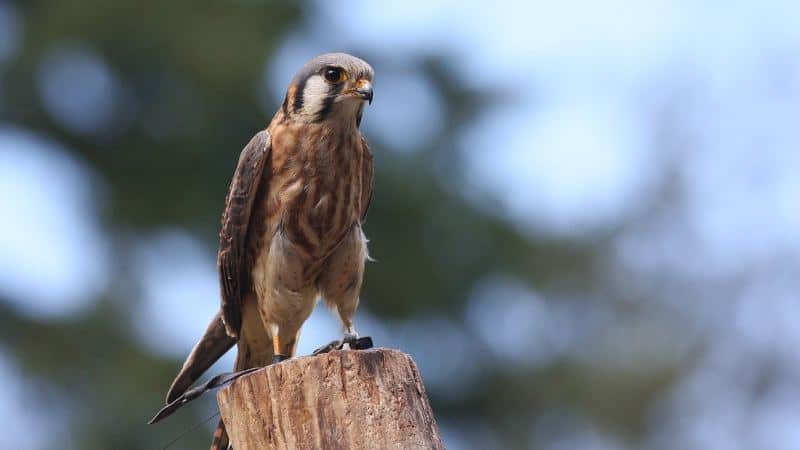
The American kestrel is often regarded as a small-sized sparrow hawk found in North America. This belongs to the family of Falconidae. Habitat: Its habitats include meadows, grasslands, deserts, parks, farm fields, cities, and suburbs.
Identification: These birds are identified by rusty brown and black bodies along the tail that have a black tip. Males have slate-blue color wings whereas the females have wings reddish brown. Adults have about 120 gm of weights and 12 inches of length.
Food: The food of American kestrel includes Grasshoppers, bugs, dragonflies, moths, caterpillars, rodents such as rats, bats, small birds such as quails, lizards, and other species as well.
American Kestrels often hunt in a group, especially the family group that enables the new or younger birds to learn the skills from adults of the group in which they live during hunting. This is the easy, safe and efficient way for birds not only to learn the skills but also to increase survival chances.
11. Northern Cardinal
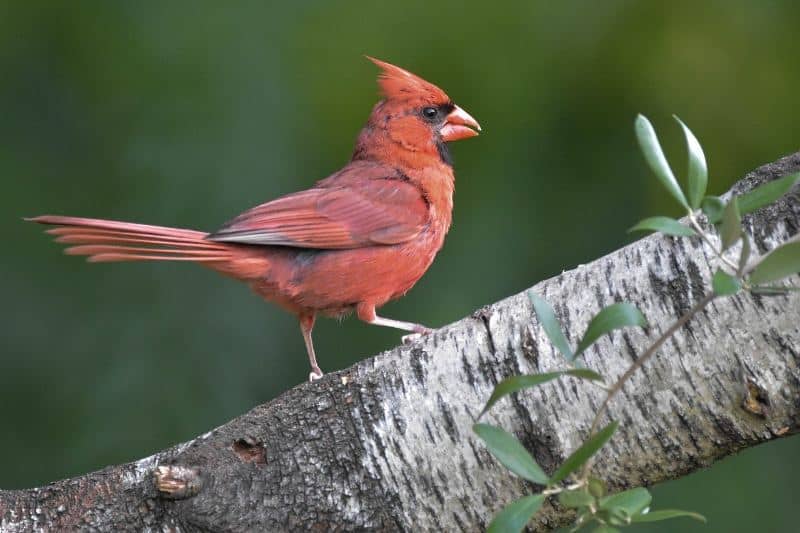
The Northern Cardinal is found in North America. The Northern Cardinal is the official state bird of North Carolina, Indiana, Ohio, Virginia, Kentucky, Illinois, and West Virginia. Habitat: Whose habitats include shrubby areas, forest edges, overgrown fields, hedgerows, backyards, marshy thickets, mesquite, regrowing forest, and ornamental landscaping.
Identification: This bird can be identified by their physical features that includes 9 inch in length, 50 gm in weight, and 12-inch wingspans. Adults can have an average lifespan of around 3 years. However, the oldest wild Northern Cardinal lived about 15 years.
Food: These are granivorous birds as their food includes seeds mostly. These seeds are opened by their cone-shaped beaks. To attract these birds, we can use seeds such as sunflower seeds safflower seeds and cracked corn. To find foods effectively Northern Cardinals flock together during the winter season.
During mating or nesting seasons, Northern Cardinals become territorial and attack other birds that try to enter their territory, and even they are found to attack their reflections in mirrors.
12. American white Pelican (Pelecanus erythrorhynchos)
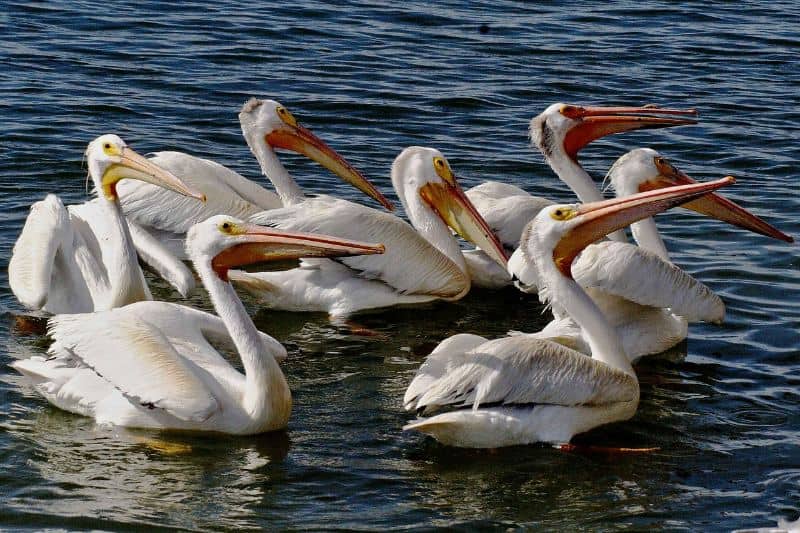
The American white pelican is a large bird that is known for aquatic soaring and is found in North America, Central America, and South America.
Habitat: The habitats of them varies according to the season, in breeding season they acquire isolated islands in freshwater lakes, Shallow wetlands, Shallow water on inland marshes, along lakes, river edges, wetlands, and deeper lakes. During migrations, they acquire catfish aquaculture farms, and in the winter, they acquire coastal, estuaries, and sloughs
Identification: This bird is identified by their physical features that includes weight about 6.1 kg, with 1.6 m in length, and have beaks that are so spacious which can fill 11 liters or 3 gallons of water in it and therefore they are considered as the birds with big and large beaks among all birds.
Food: The foods of American white pelican include fishes, However, while fishing they may end up catching the small reptile or amphibian that they eat. These are found to breathe through their beaks as they do not have nostrils like the other birds, which is interesting!
13. American Robin
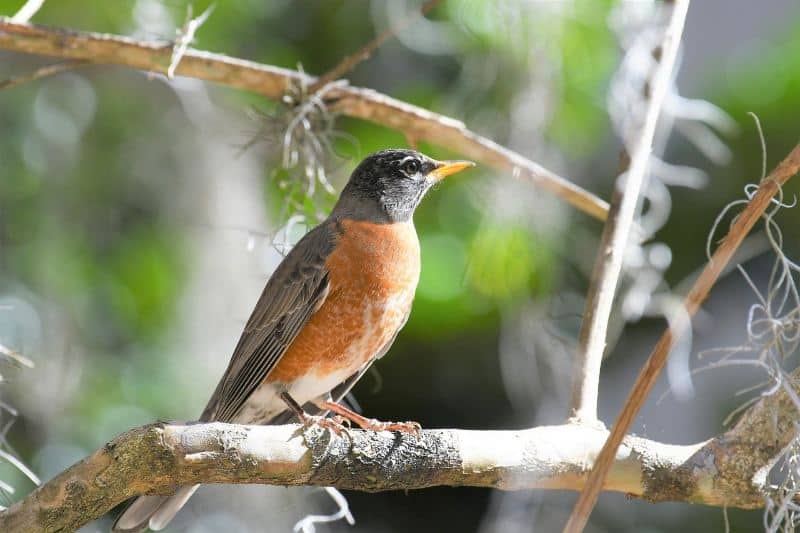
Robins are found in Northern America as well as in Europe. They are also seen in Mexico, Alaska, and Canada. The American Robin is the national bird of Great Britain also is the state bird for Connecticut, Michigan, and Wisconsin. Habitat: Its habitats are lawns, fields, city parks, wild woodlands, forests, mountains, and tundra.
Identification: The American Robin is identified by the following characters like male and female look similar and is found to be running and stopping which is one of the main characteristics of it. The average lifespan of these birds is around 2-3 years but some are found to live for 14 years.
Food: The food of American Robin includes worms, earthworms, insects, snails, present in the garden, fruits such as chokecherries, hawthorn, dogwood, juniper berries. When they eat fermented berries that bring them to drunk behaviors.
American Robins including some other robins can migrate to distances that are around 3,000 miles and can lay sky-blue colored eggs that take 14-15 days to hatch while also capable of recognizing the other bird eggs that laid in their nest and can remove before they can hatch and trouble the robin chick for food and other basic needs.
14.American Oystercatcher (Haematopus palliatus)
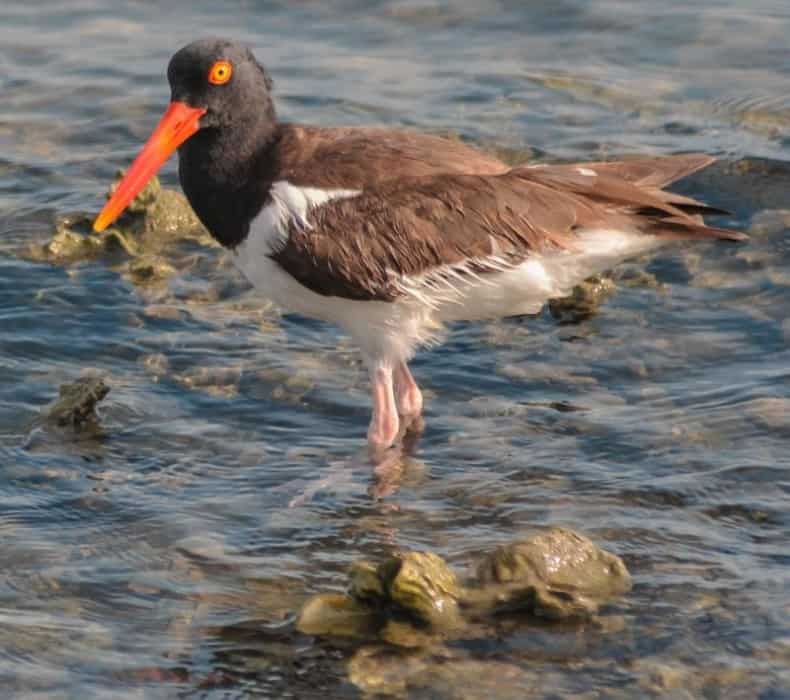
American oystercatcher found in the coastal island, salt marshes of North America, Northern Florida, Gulf Coast, south to Brazil, Argentina, Pacific coast of California, and Mexico. Habitat: Its habitats include barrier islands, shelly beach, saltmarshes, and agricultural fields.
Identification: The American oystercatcher is identified by a blackhead, brown back, white belly, large white patches on its wings, tail. It has eyes of yellow with an orange ring surrounded by it, pale pink legs with an orange bill. They weigh around 560 g with 19 inches of length that belong to the family Haematopodidae.
Food: The foodof American oystercatcher includes mainly saltwater bivalve mollusks, and other clams, oysters, mussels, jellyfish, starfish, sea urchins, marine worms, lady crabs, and speckled crabs.
15.California Gnatcatcher (Polioptila californica)

The gnatcatcher is foundaround coastal southern California, northwestern Mexico, and California. Habitat: Its habitatsinclude coastal sage scrub, desert scrub, and coastal dune scrub, sagebrush, desert woodlands, coastal dune scrub, and desert scrub.
Identification: The California gnatcatcher is a small insectivorous bird that lives in solitary but in winter in groups, which are identifiedby their physical features that includes 6 gm of weight with a length of 10.8 cm, 14 cm of wingspan and belongs to Polioptilidae family. Their overall body is dark gray with a black tail, Males have a black cap whereas the females have a thin white eyeing.
Food: The California Gnatcatcher foodsinclude leafhoppers, spiders, beetles, bugs, and other invertebrates.
The California gnatcatcher is known for its traits, such as the dark grey body, the grey ventral body, the black tail, the white tip. A black cap identifies the males, while a thin white eye ring identifies the females.
16. American Crow

They are foundand are common in the United States and across the world as well.
Habitat: Whose habitatsinclude both natural and human created habitats, farmland, pasture, landfills, city parks, golf courses, yards, vacant lots, highway turnarounds, feedlots, and the shores of rivers, streams, and marshes.
Identification: American Crows are identifiedby black color all over the body, including the legs and bill, also have thick neck, sturdy and straight bill, and short tail. Which have average lifespan around 10-15 years and the maximum lifespan recorded is more than 30 years.
Food: The foods for American Crows can include both plant-derived and animal-derived foods that include snail, crab, table scraps, other animals like cat and dog food.
American Crows including their family members are intelligent birds as they understand and imitate human languages and are found to hide shining objects such as metals, keys, and jewelry. However, they can’t be kept as a pet without a license but we can feed those visiting our gardens with careful attention as they can give bites that are strong enough to crush small bones, usually the finger bones.
17.Florida Scrub-Jay (Aphelocoma coerulescens)

The Florida scrub-jay is a bird foundin North America and is also listed as endemic to the Florida state of the United States. Habitat: Its habitatsinclude oak scrub and scrubby flatwoods.
Identification: These are identifiedby a dull blue colored body with whitish forehead, pale gray back and belly, a long tail, a big flat head and a heavy bill. Adults have a length of 30 cm, a weight of 77 gm and belong to the Corvidae family.
Food: The foodsof Florida scrub-jay are insects, frogs, toads, lizards, mice, other bird eggs, and Acorns that all make it an omnivorous bird.
Some Florida scrub jay birds are interested in safeguarding the nestling from the hawks and snakes, while the other Florida scrub jay birds are engaged in seeking food, however, if any threats occur, they will provide different alarm calls for different threats, thereby alerting the remaining Jay birds to participate in protecting the nest.
18. American Black Vulture (Coragyps atratus)

The American black vulture, also known as the black vulture, are the vulture birds foundin the northeastern United States to Peru, Central Chile and Uruguay in South America.
Habitat: Whose habitatincludes low elevations, dense woodlands, semi-rural suburbs and close to water.
Identification: The American black vulture is identifiedby its physical features that include black colored skinny, bare neck because there are no feathers in their necks, broad and rounded wings, short and round tails, white patches at wingtips that are visible while flying. Adults have a length of 74 cm with a wingspan of about 1.7 m and a lifespan of 10 years, weighing about 2 kg.
Food: The black vulture is a scavenger that feeds on carrion, eggs or can kill newborn animals and mammals. They have developed resistance to pathogenic microorganisms and their toxins that are present in the dead body of an animal.
Read More : Eagle Vs Hawk ?
19.Red-Winged Blackbird (Agelaius phoeniceus)

The red-winged blackbird is a passerine bird that belongs to the family Icteridae which are usually foundin North and Central America. Habitat: Its habitatsare saltwater marshes, watercourses, water hazards on golf courses, wet roadsides, drier meadows. In winter, they will be seen in crop fields and feedlots.
Identification: These are identified by the physical features such as broad-shouldered bird with a black color body, conical shaped bill, and a medium-length tail. The biometrics includes 23 cm of length, 77 g of weight and 40 cm of wingspan. The male has glossy black bodies with red to yellow color badges on their bodies. Whereas the females dark brownish color all over the body along paler color on the breast with a whitish eyebrow.
Food: These feed on seeds, corn, sunflowers, wheat, aquatic plants using their slender bills, insects, weed seeds including ragweed and waste grains. To attract them to your garden spread grain and seed on your garden.
20.Downy Woodpecker (Dryobates pubescens)
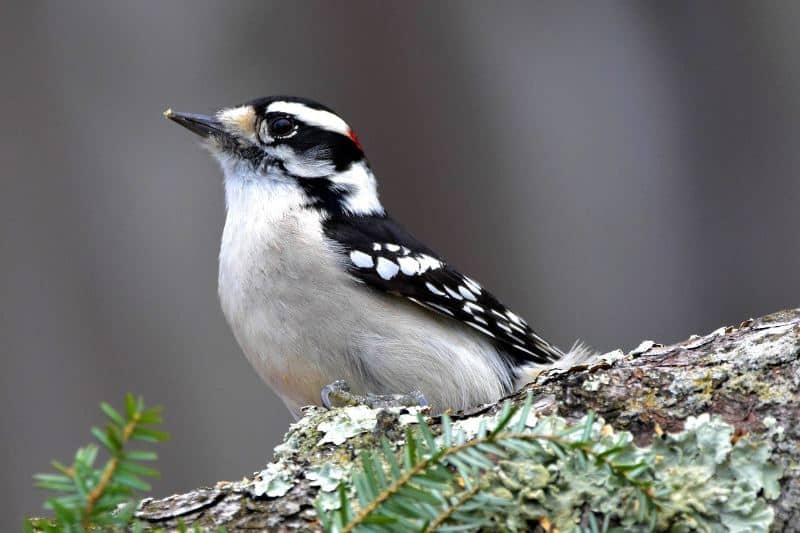
It is a type of woodpecker that is smallest in size among many types of woodpecker which are found in North America. Habitat: Its habitatsinclude open woodlands, deciduous trees, orchards, city parks, and backyards.
Identification: The Downy Woodpeckers identified by the relatively small body and bill when compared to other woodpeckers, along black and white plumage due to the presence of white check on the wings, white and black spot tails. Males have a small red patch on the back of the head. Its biometrics include 7 inch in length, 30 gm in weight, and 12 inch in wingspan.
Food: The food of these includes insects, beetle larvae, ants, caterpillars, corn earworm, tent caterpillars, bark beetles, apple borers, berries, acorns, and grains. They also visit feeders to eat suet, black oil sunflower seeds, and artificial nectars from hummingbird feeders.
21. Red-Bellied Woodpecker (Melanerpes carolinus)
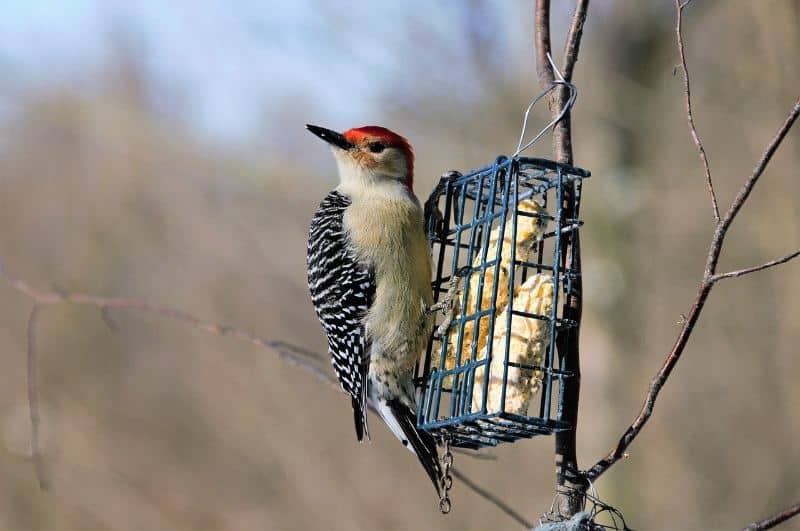
The red-bellied woodpecker is a red-headed woodpecker belonging to the Picidae family. These are foundin the eastern United States, Florida, and Canada. Habitat: The habitats of the Red-bellied Woodpeckers are Eastern woodlands, forests, hardwoods, eastern forests, woodlands pines, and sometimes visit your backyard feeders as well.
Identification: These can be identified by their biometrics, that are 72 g in weight, 27 cm in length, and the morphological features include black-and-white striped back, flashing red cap and nape, and white patches at the wingtips while the bird flies.
Food: They feed on insects, spiders, acorns, tree nuts, wild fruit, sunflower seed, suet, and peanuts. These can be attracted to your gardens by offering foods such as Sunflower Seed, Suet, Peanuts, Forest, Open Woodland, and Dead Trees. While they also like Trees and Shrubs such as American elderberry, Red Mulberry, Flowering Dogwood, Eastern White Pine, Dead Trees for Insects, Nesting, and Oak.
The predators of red-bellied woodpeckers are hawks, Cooper’s hawks, black rat snakes, house cats. The predators for eggs and chicks of red-bellied woodpeckers are European starlings, pileated woodpeckers, gray rat snakes, and black rats.
22.Song Sparrow (Melospiza melodia)
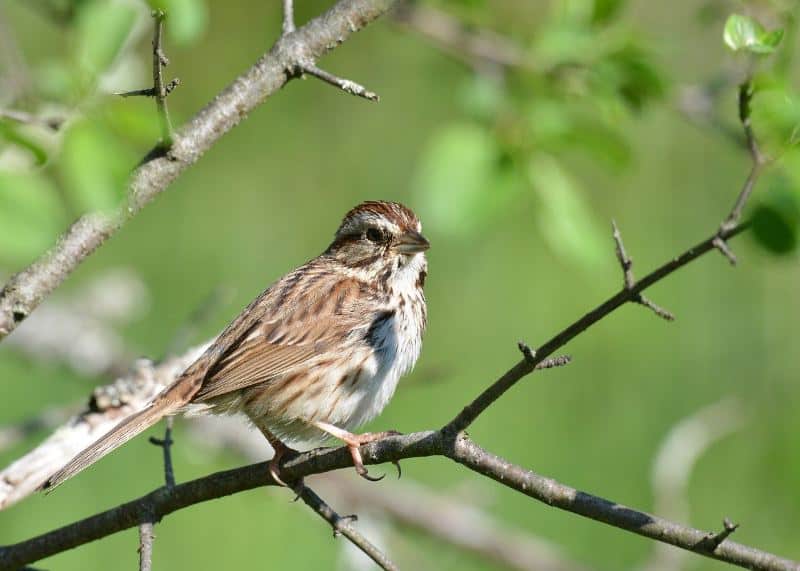
The song sparrow is a medium sized bird that belongs to the new world sparrow which is found in North America.
Habitat: Thehabitatsof song sparrow include tidal marshes, arctic grasslands, desert scrub, pinyon pine forests, aspen park lands, Pacific rain forest, agricultural fields, overgrown pastures, freshwater marsh, lake edges, forest edges, suburbs, and sometimes in deciduous or mixed woodlands.
Identification: The song sparrows are identified by their morphological features that includes medium-sized bodies, short bill, round head, long and round tails with broad wings. They have brown-grey plumage in which thick streaks on a white chest and red-brown and gray feathers on their head. Its biometrics are 7 inch in length, 50 gm in weight and 9 inches of wingspan.
Food: Song Sparrows feed on weevils, leaf beetles, ground beetles, caterpillars, dragonflies, grasshoppers, midges, spiders, snails, and earthworms. buckwheat, ragweed, clover, sunflower, wheat, rice, blackberries, blueberries, strawberries, raspberries, and mulberries.
23. Dark-eyed Junco (Junco hyemalis)
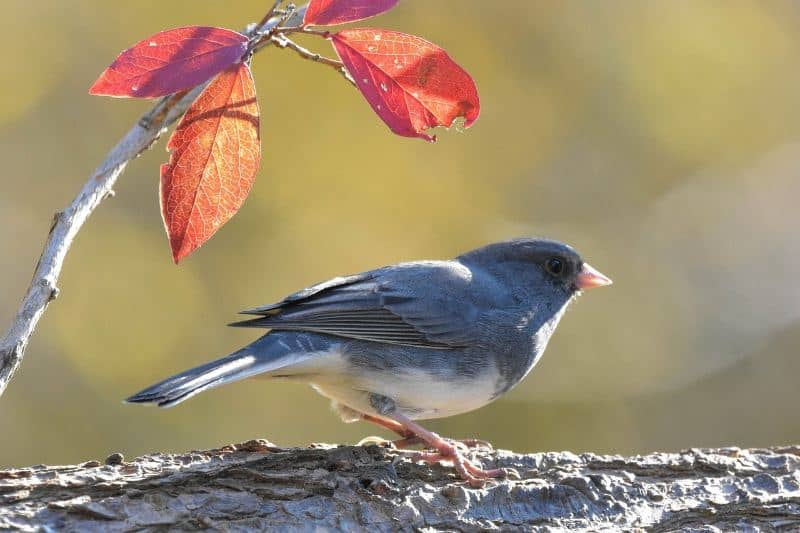
The dark-eyed junco is a species of junco that are foundin temperate North America.
Habitat: Its habitatsinclude coniferous forests such as pine, spruce, deciduous forests such as cottonwood, oak, maple, open woodlands, parks, and gardens.
Identification: These are identified by physical features that include a length of 16 cm, a weight of 30 gm, and a wingspan of 25 cm. They are medium-sized sparrows having dark gray-brownish bodies, round heads, a short tail, and a long bill.
Food: Their foods include seed, chickweed, buckwheat, sorrel, millet, insects like beetles, moths, butterflies, caterpillars, ants, wasps, and flies.
24. Baltimore Oriole (Icterus galbula)
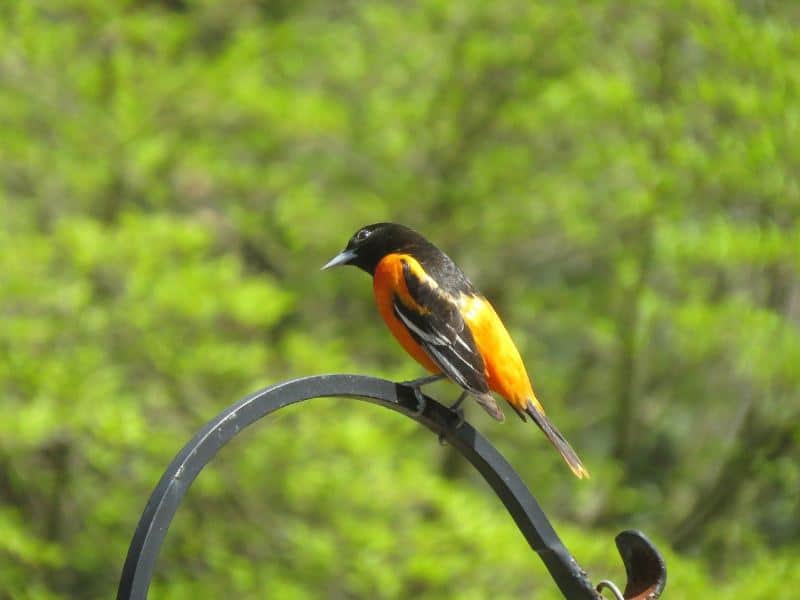
The Baltimore oriole is a small icterid blackbird that isfound in eastern North America.
Habitat: Its habitatsinclude leafy deciduous trees, open woodland, forest edge, river banks, small groves of trees, parks, orchards, backyards, gardens, coffee plantations and cacao plantations.
Identification: They are identified by their physical features that includes a length of 20 cm, a wingspan of 30 cm and a weight of 40 gm. They have medium sized-bodies that are orange-black in color, black head, a thick neck, long legs, thick and pointed bills.
Food: They feed on insects, fruit, nectar, beetles, crickets, grasshoppers, moths, flies, spiders, snails, caterpillars, gypsy moth caterpillars, and spiny elm caterpillars
25.Yellow-Rumped Warbler (Setophaga coronata)

The yellow-rumped warbler is a black and yellow colored bird that is found in North American. Habitat: Its habitats include mixed coniferous-deciduous woodlands, parks, streamside, woodlands, pine-oak forest, dunes, mangroves, thorn scrub, pine-oak-fir forests, and shade coffee plantations.
Identification: These birds are identified by their physical features that includes a relatively large body, a large head, strong bill, with long and narrow tail. The adult birds weigh about 13 gm, having a length of 14 cm and a wingspan of 23 cm.
Food: They feed on mainly insects such as caterpillars, leaf beetles, bark beetles, weevils, ants, scale insects, aphids, caddisflies, and grasshoppers. The fruits such as bayberry, wax myrtle, juniper berries, poison ivy, poison oak, greenbrier, grapes, Virginia creeper, and dogwood. wild seeds such as beach grasses, goldenrod, and sunflower seeds.
